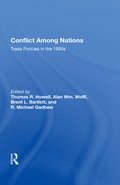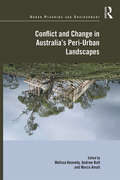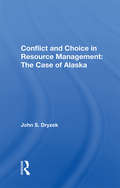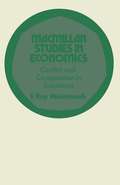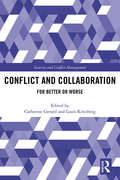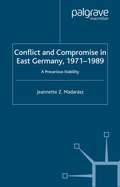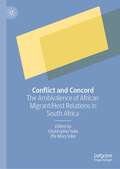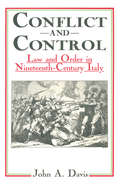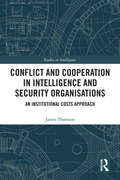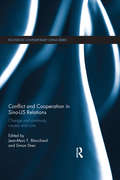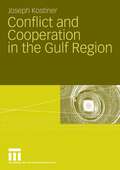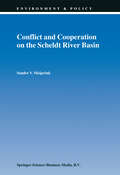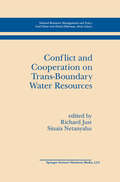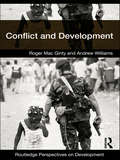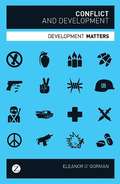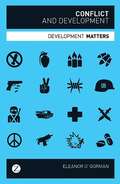- Table View
- List View
Conflict Among Nations: Trade Policies In The 1990s
by Thomas R. Howell Alan Wm. Wolff Brent L. Bartlett R. Michael GadbawThis book presents a study of the trade objectives and strategies of Japan, Germany, South Korea, Taiwan, Brazil and the European Community, and of the implications of the policies for both the US and the international trading system of the 1990s.
Conflict and Change in Australia’s Peri-Urban Landscapes (Urban Planning and Environment)
by Melissa Kennedy Andrew Butt Marco AmatiIn an era of rapid urbanization, peri-urban areas are emerging as the fastest-growing regions in many countries. Generally considered as the space extending one hundred kilometres from the city fringe, peri-urban areas are contested and subject to a wide range of uses such as residential development, productive farming, water catchments, forestry, mineral and stone extraction and tourism and recreation. Whilst the peri-urban space is valued for offering a unique ambiance and lifestyle, it is often highly vulnerable to bushfire and loss of biodiversity and vegetation along with threats to farming and food security in highly productive areas. Drawing together leading researchers and practitioners, this volume provides an interdisciplinary contribution to our knowledge and understanding of how peri-urban areas are being shaped in Australia through a focus on four overarching themes: Peri-urban Conceptualizations; Governance and Planning; Land Use and Food Production; and Solutions and Representations. Whilst the case studies focus on Australia, they advance a variety of tools useful in discerning processes and impacts of peri-urban change globally. Furthermore, the findings are instructive of the issues and tensions commonly encountered in rapidly urbanizing peri-urban areas throughout the world, from landscape valuation and biosecurity concerns to functional adaptation and social change.
Conflict and Change in Australia’s Peri-Urban Landscapes (Urban Planning and Environment)
by Melissa Kennedy Andrew Butt Marco AmatiIn an era of rapid urbanization, peri-urban areas are emerging as the fastest-growing regions in many countries. Generally considered as the space extending one hundred kilometres from the city fringe, peri-urban areas are contested and subject to a wide range of uses such as residential development, productive farming, water catchments, forestry, mineral and stone extraction and tourism and recreation. Whilst the peri-urban space is valued for offering a unique ambiance and lifestyle, it is often highly vulnerable to bushfire and loss of biodiversity and vegetation along with threats to farming and food security in highly productive areas. Drawing together leading researchers and practitioners, this volume provides an interdisciplinary contribution to our knowledge and understanding of how peri-urban areas are being shaped in Australia through a focus on four overarching themes: Peri-urban Conceptualizations; Governance and Planning; Land Use and Food Production; and Solutions and Representations. Whilst the case studies focus on Australia, they advance a variety of tools useful in discerning processes and impacts of peri-urban change globally. Furthermore, the findings are instructive of the issues and tensions commonly encountered in rapidly urbanizing peri-urban areas throughout the world, from landscape valuation and biosecurity concerns to functional adaptation and social change.
Conflict And Choice In Resource Management: The Case Of Alaska
by John S. DryzekThis book examines the process of policymaking in situations in which the interests, values, and rights of the various actors conflict with one another and suggest contradictory courses of action. Focusing on the problems of resource management in Alaska's coastal and offshore regions, Dr. Dryzek shows how present mechanisms and analytical techniqu
Conflict And Choice In Resource Management: The Case Of Alaska
by John S. DryzekThis book examines the process of policymaking in situations in which the interests, values, and rights of the various actors conflict with one another and suggest contradictory courses of action. Focusing on the problems of resource management in Alaska's coastal and offshore regions, Dr. Dryzek shows how present mechanisms and analytical techniqu
Conflict and Collaboration: For Better or Worse (Routledge Studies in Security and Conflict Management)
by Catherine Gerard Louis KriesbergIn this volume, scholars from different disciplines join together to examine the overlapping domains of conflict and collaboration studies. It examines the relationships between ideas and practices in the fields of conflict resolution and collaboration from multiple disciplinary perspectives. The central theme is that conflict and collaboration can be good, bad, or even benign, depending on a number of factors. These include the role of power, design of the process itself, skill level and intent of the actors, social contexts, and world views. The book demonstrates that various blends of conflict and collaboration can be more or less constructively effective. It discusses specific cases, analytical methods, and interventions, and emphasizes both developing propositions and reflecting on specific cases and contexts. The book concludes with specific policy recommendations for many sets of actors—those in peacebuilding, social movements, governments, and communities—plus students of conflict studies. This book will be of much interest to students, scholars, and practitioners of peace and conflict studies, public administration, sociology, and political science.
Conflict and Collaboration: For Better or Worse (Routledge Studies in Security and Conflict Management)
In this volume, scholars from different disciplines join together to examine the overlapping domains of conflict and collaboration studies. It examines the relationships between ideas and practices in the fields of conflict resolution and collaboration from multiple disciplinary perspectives. The central theme is that conflict and collaboration can be good, bad, or even benign, depending on a number of factors. These include the role of power, design of the process itself, skill level and intent of the actors, social contexts, and world views. The book demonstrates that various blends of conflict and collaboration can be more or less constructively effective. It discusses specific cases, analytical methods, and interventions, and emphasizes both developing propositions and reflecting on specific cases and contexts. The book concludes with specific policy recommendations for many sets of actors—those in peacebuilding, social movements, governments, and communities—plus students of conflict studies. This book will be of much interest to students, scholars, and practitioners of peace and conflict studies, public administration, sociology, and political science.
Conflict and Colonialism in 21st Century Romantic Historical Fiction: Repairing the Past, Repurposing History (Routledge Research in Women's Literature)
by Hsu-Ming Teo and Paloma Fresno-CallejaThis book explores how postmillennial Anglophone women writers use romantic narrativisations of history to explore, revise, repurpose and challenge the past in their novels, exposing the extent to which past societies were damaging to women by instead imagining alternative histories. The novelists discussed employ the generic conventions of romance to narrate their understanding of historical and contemporary injustice and to reflect upon women’s achievements and the price they paid for autonomy and a life of public purpose. The volume seeks, firstly, to discuss the work of revision or reparation being performed by romantic historical fiction and, secondly, to analyse how the past is being repurposed for use in the present. It contends that the discourses and genre of romance work to provide a reparative reading of the past, but there are limitations and entrenched problems in such readings.
Conflict and Colonialism in 21st Century Romantic Historical Fiction: Repairing the Past, Repurposing History (Routledge Research in Women's Literature)
This book explores how postmillennial Anglophone women writers use romantic narrativisations of history to explore, revise, repurpose and challenge the past in their novels, exposing the extent to which past societies were damaging to women by instead imagining alternative histories. The novelists discussed employ the generic conventions of romance to narrate their understanding of historical and contemporary injustice and to reflect upon women’s achievements and the price they paid for autonomy and a life of public purpose. The volume seeks, firstly, to discuss the work of revision or reparation being performed by romantic historical fiction and, secondly, to analyse how the past is being repurposed for use in the present. It contends that the discourses and genre of romance work to provide a reparative reading of the past, but there are limitations and entrenched problems in such readings.
Conflict and Compromise in East Germany, 1971–1989: A Precarious Stability
by J. MadarászThis extensively researched empirical analysis of the GDR in the years 1971-1989 challenges current historical interpretations of GDR history. It focuses on four social groups - youth, women, writers and Christians - to highlight the stability of this socialist society until 1987. The strength of the regime is shown to have been based on a continuously negotiated process of give-and-take involving major parts of the population.
Conflict and Concord: The Ambivalence of African Migrant/Host Relations in South Africa
by Christopher Isike Efe Mary IsikeThe book is a response to the dominant discourse of South Africa as unwelcoming to African immigrants. Acknowledging the reality of xenophobia against African migrants in South Africa, it explores the positive spaces of interactions between South Africans and African migrants that do not necessarily result in tension. Hence, the book is about conviviality, cohabitation, interdependency and the production of a multicultural rainbow nation. South Africa, its constitution and representation as a multicultural society is the perfect context to experiment with the ideas in the book. Part of the objectives is therefore to demonstrate, as contained in the title, the ambivalence of this relationship which the popular discourse of xenophobia has silenced.
Conflict and Consensus in France (Routledge Revivals)
by Vincent WrightFirst published in 1979, in Conflict and Consensus in France a number of authorities on French politics examine some of the basic problems of legitimacy, consensus formation and conflict resolution which the regime continues to face after the elections of March 1978. Early in 1978 the French Fifth Republic, then twenty five years old, appeared to be facing a major political and constitutional crisis. That crisis did not materialize as the result of the totally unexpected defeat of the left in the March 1978 elections.Professor Douglas Johnson analyses the historical debate about the divisions in French society. John Frears raises the question of the validity of President Giscard d’Estaing’s views on legitimacy and consensus. Vincent Wright looks at the conflicts which emerged during the March 1978 election campaign and the extent to which they have been resolved. ‘Dissentient France’ is examined by Professor Jack Hayward while Anne Stevens explores the conflicts which riddle the French administration. Four policy areas are then analyzed by Diana Green, Ezra Suleiman, Dorothy Pickles and Howard Machin in order to determine the extent of conflict and consensus among the French political elites. This is an important historical reference work for students and scholars of French politics.
Conflict and Consensus in France (Routledge Revivals)
First published in 1979, in Conflict and Consensus in France a number of authorities on French politics examine some of the basic problems of legitimacy, consensus formation and conflict resolution which the regime continues to face after the elections of March 1978. Early in 1978 the French Fifth Republic, then twenty five years old, appeared to be facing a major political and constitutional crisis. That crisis did not materialize as the result of the totally unexpected defeat of the left in the March 1978 elections.Professor Douglas Johnson analyses the historical debate about the divisions in French society. John Frears raises the question of the validity of President Giscard d’Estaing’s views on legitimacy and consensus. Vincent Wright looks at the conflicts which emerged during the March 1978 election campaign and the extent to which they have been resolved. ‘Dissentient France’ is examined by Professor Jack Hayward while Anne Stevens explores the conflicts which riddle the French administration. Four policy areas are then analyzed by Diana Green, Ezra Suleiman, Dorothy Pickles and Howard Machin in order to determine the extent of conflict and consensus among the French political elites. This is an important historical reference work for students and scholars of French politics.
Conflict and Cooperation in Intelligence and Security Organisations: An Institutional Costs Approach (Studies in Intelligence)
by James ThomsonThis book provides an institutional costs framework for intelligence and security communities to examine the factors that can encourage or obstruct cooperation. The governmental functions of security and intelligence require various organisations to interact in a symbiotic way. These organisations must constantly negotiate with each other to establish who should address which issue and with what resources. By coupling adapted versions of transaction costs theories with socio-political perspectives, this book provides a model to explain why some cooperative endeavours are successful, whilst others fail. This framework is applied to counterterrorism and defence intelligence in the UK and the US to demonstrate that the view of good cooperation in the former and poor cooperation in the latter is overly simplistic. Neither is necessarily more disposed to behave cooperatively than the other; rather, the institutional costs created by their respective organisational architectures incentivise different cooperative behaviour in different circumstances. This book will be of much interest to students of intelligence studies, organisational studies, politics and security studies.
Conflict and Cooperation in Intelligence and Security Organisations: An Institutional Costs Approach (Studies in Intelligence)
by James ThomsonThis book provides an institutional costs framework for intelligence and security communities to examine the factors that can encourage or obstruct cooperation. The governmental functions of security and intelligence require various organisations to interact in a symbiotic way. These organisations must constantly negotiate with each other to establish who should address which issue and with what resources. By coupling adapted versions of transaction costs theories with socio-political perspectives, this book provides a model to explain why some cooperative endeavours are successful, whilst others fail. This framework is applied to counterterrorism and defence intelligence in the UK and the US to demonstrate that the view of good cooperation in the former and poor cooperation in the latter is overly simplistic. Neither is necessarily more disposed to behave cooperatively than the other; rather, the institutional costs created by their respective organisational architectures incentivise different cooperative behaviour in different circumstances. This book will be of much interest to students of intelligence studies, organisational studies, politics and security studies.
Conflict and Cooperation in Sino-US Relations: Change and Continuity, Causes and Cures (Routledge Contemporary China Series)
by Jean-Marc F. Blanchard Simon ShenNumerous crosswinds are buffeting the more than 40-year-old People's Republic of China--American relationship, yet only once since Nixon’s historic trip to China in 1972 has a major conflagration seemed a real possibility. Anchoring the relationship throughout multiple storms are the two countries’ broad areas of collaboration such as deep links in culture, economics, and education. However, for some observers, the conflictual aspects of the relationship seem to be gaining prominence. Conflict and Cooperation in Sino-US Relations offers a timely and current look at one of the world’s weightiest bilateral relationships. It goes beyond detailing the conflict and cooperation that have been integral facets of China--US interactions since 1972, to gauging the relationship's evolution and future trends, examining its nuances regarding diverse issues such as the Asia-Pacific leadership structure, the South China Sea, and the Korean peninsula. The book further delves into the causes of conflict and cooperation, offers diverse solutions for tempering frictions between Beijing and Washington, and considers the efficacy of some of the mechanisms (e.g., military-to-military exchanges) that China and the US currently employ to manage their relationship.The chapters suggest that extreme anxieties about China--US relations may be misplaced, but that there nonetheless are some worrisome signs even in areas like economics and the environment that are perceived as naturally cooperative. While the book does not offer any silver bullets, various contributors contend that successful management of Sino-American relations may require greater American accommodation of China’s interests. This book will be of great interest to students and scholars of Chinese politics, American politics, international relations, and Asian studies, as well as to policy-makers working in the field.
Conflict and Cooperation in Sino-US Relations: Change and Continuity, Causes and Cures (Routledge Contemporary China Series)
by Jean-Marc F. Blanchard Simon ShenNumerous crosswinds are buffeting the more than 40-year-old People's Republic of China--American relationship, yet only once since Nixon’s historic trip to China in 1972 has a major conflagration seemed a real possibility. Anchoring the relationship throughout multiple storms are the two countries’ broad areas of collaboration such as deep links in culture, economics, and education. However, for some observers, the conflictual aspects of the relationship seem to be gaining prominence. Conflict and Cooperation in Sino-US Relations offers a timely and current look at one of the world’s weightiest bilateral relationships. It goes beyond detailing the conflict and cooperation that have been integral facets of China--US interactions since 1972, to gauging the relationship's evolution and future trends, examining its nuances regarding diverse issues such as the Asia-Pacific leadership structure, the South China Sea, and the Korean peninsula. The book further delves into the causes of conflict and cooperation, offers diverse solutions for tempering frictions between Beijing and Washington, and considers the efficacy of some of the mechanisms (e.g., military-to-military exchanges) that China and the US currently employ to manage their relationship.The chapters suggest that extreme anxieties about China--US relations may be misplaced, but that there nonetheless are some worrisome signs even in areas like economics and the environment that are perceived as naturally cooperative. While the book does not offer any silver bullets, various contributors contend that successful management of Sino-American relations may require greater American accommodation of China’s interests. This book will be of great interest to students and scholars of Chinese politics, American politics, international relations, and Asian studies, as well as to policy-makers working in the field.
Conflict and Cooperation in the Gulf Region
by Joseph KostinerThis book analyzes four main episodes of conflict and defense which have affected the region during the last three decades: the Iran-Iraq war (1980-1988), which effected the Gulf Cooperation Council (GCC) from a close, neighborly distance; the Iraq-Kuwait war (1990-1991), which constituted an attempt to invade the GCC and eliminate one of its member states, Kuwait. And the subsequent attempts to reestahblish a regional inter-state stability in the Gulf (during the mid-1990s, approximately), and the war of Islamic terrorism (notably al-Qa'ida) against Saudi Arabia (leading up to 2005). Each episode was driven by inimical interests and evolved as a distabilizintg influence on the Gulf states. At the same time, each conflict resulted in a paradoxical combination rivalry and cooperation among the GCC states themselves. A perpetual sequence of conflict and cooperation thus developed.
Conflict and Cooperation on the Scheldt River Basin: A Case Study of Decision Making on International Scheldt Issues between 1967 and 1997 (Environment & Policy #17)
by S.V. MeijerinkMore than 200 major river basins are shared by two or more countries and, together, these basins account for about 60% of the earth's land area, constituting a significant portion of the world's fresh water resources. They are thus both a significant asset to the nations sharing them, as well as a potential source of conflict. This book presents a generic framework for the analysis of decision making on international river issues. It emphasises the strategic character of the interactions between the basin states and addresses learning and institutionalization processes, taking account of the influence of the context on the decision making process. The case of the river Scheldt covers negotiations on the Belgian-Dutch water conventions covering a number of international issues relating to the river basins of the Scheldt and the Meuse, such as construction projects aimed at improving the maritime access to the port of Antwerp, the maintenance of the navigation channel in the Western Scheldt, pollution of the waters in the two rivers, and the distribution of water from the Meuse. The final part of the book contains a typology of strategies for the solution of upstream-downstream problems in international river basins. Audience: All those interested in international water and environmental management, international negotiations and politics, and public policy.
Conflict and Cooperation on Trans-Boundary Water Resources (Natural Resource Management and Policy #11)
by Richard E. Just Sinaia NetanyahuThis book demonstrates what the discipline of economics has to offer as support for analyzing cooperation on management of trans-boundary water resources. It also considers what the discipline of economics has to acquire to become a more effective contributor to trans-boundary water resource management given political, legal, social, physical, scientific, and ecological realities. This book has its genesis in a symposium of the International Water and Resource Economics Consortium held at Annapolis, Maryland, April 13-16, 1997. The symposium was organized by the editors and the book contains papers presented at the symposium with subsequent revisions. The symposium brought together both economists and agency management personnel for the purpose of discussing not only how economic tools apply to trans-boundary water management, but also of identifying the obstacles to making such tools useful and informative to politicians and negotiators in public decision making roles. INTERNATIONAL VERSUS DOMESTIC TRANS-BOUNDARY PROBLEMS Trans-boundary water problems arise in many dimensions. The two most important types of problems emphasized in this book are international and domestic interstate or interregional problems. Cooperation on international problems is especially difficult because enforcement must be voluntary given the sovereignty of nations and the absence of an effective legal enforcement mechanism. Agreements must be sustainable and self-enforced if they are to have lasting benefits. Every negotiating country must be convinced it will receive benefits before it gives its consent to cooperation. In the absence of enforceable agreements, trans-boundary (i. e.
Conflict and Development
by Roger Mac Ginty Andrew WilliamsOver the past decade, a new awareness of the relationship between conflicts and development has grown. Developmental factors can act as a trigger for violence, as well as for ending violence and for triggering post-conflict reconstruction. This book explores the complexity of the links between violent conflict (usually civil wars) and development, under-development and uneven development. It emphasizes the connections between stable developed economies and civil wars in other parts of the world, and examines how structural factors (such as the organization of the global economy) virtually condemn some regions to conflict and under-development. This valuable introductory text explains, reviews and critically evaluates this complex relationship. It focuses on intra-state conflicts and complex political emergencies that combine transnational and internal characteristics. Attention is also given to inter-state conflicts. Chapters emphasize how the relationship between conflict and development traverses many scales (macro, meso and micro) and dimensions (economic, political and cultural). Furthermore it explains how different developmental challenges and opportunities emerge along the full life-cycle of conflict. Specifically, the role of poverty, state, market, civil society, globalization, humanitarian aid, refuges, gender and health within conflict dynamics are examined. The book also investigates specific developmental issues emerging during conflict management and post conflict reconstruction. Both authors have a background in conducting research in deeply divided societies, and argue that many of the processes connected with war and peace making deliberately write people out of the equation. This book attempts to ‘write people in’. By drawing on contemporary theoretical debates and examining current policies and events, the text unpacks the difficult and complex aspects of the relationships between armed conflict and development and makes them accessible, interesting and policy relevant. It considers how peace making, peace building, and post-war reconstruction are usually more sustainable and successful if politicians, policy makers, entrepreneurs and those working for international NGOs take on board local opinion and capacity. Written in an accessible style, the book considers the main contemporary theories and arguments on conflict, development and the interactions between the two. The text is illuminated throughout with case studies drawn from Africa, the Balkans, Asia and the Middle East.
Conflict and Development (Development Matters)
by Eleanor O' GormanDuring the 1990s the drive of liberal peace efforts in the form of humanitarian intervention transformed the ways in which traditional development assistance operated in war and post-war situations. From Somalia and Rwanda to Bosnia and Sri Lanka, conflict, security and development became more intertwined as more integrated programmes and interventions were advocated by the international community.Conflict and Development, whilst serving as an in-depth introduction to key themes and context, questions the extent to which international aid has over-reached in seeking to engage more centrally in addressing the causes and consequences of violent conflict. Using this framework, the author traces the evolution of the conflict and development agenda and explores the politics of aid and policymaking in relation to international conflict.By taking a combined approach of theory, policy and practice this vital new book explores and comprehensively explains the impact of conflict on development and vice-versa through the series of concise thematic chapters.
Conflict and Development (Development Matters)
by Eleanor O' GormanDuring the 1990s the drive of liberal peace efforts in the form of humanitarian intervention transformed the ways in which traditional development assistance operated in war and post-war situations. From Somalia and Rwanda to Bosnia and Sri Lanka, conflict, security and development became more intertwined as more integrated programmes and interventions were advocated by the international community.Conflict and Development, whilst serving as an in-depth introduction to key themes and context, questions the extent to which international aid has over-reached in seeking to engage more centrally in addressing the causes and consequences of violent conflict. Using this framework, the author traces the evolution of the conflict and development agenda and explores the politics of aid and policymaking in relation to international conflict.By taking a combined approach of theory, policy and practice this vital new book explores and comprehensively explains the impact of conflict on development and vice-versa through the series of concise thematic chapters.
